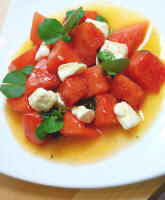|
Â
3ed August is National Watermelon Day
Watermelons pack a mighty nutrient punch
Â
Despite
being 92% water, these heavyweights not only pack a vitamin and mineral punch,
but are also rich in carotenoids and contain amino acids.
Included in the count are vitamins A, C, B6, Zinc, Copper, Phosphorus,
Magnesium and Potassium, amino acids such as citrulline and arginine which help
maintain the arteries and carotenoids such as lycopene, beta-carotene and lutein.
Lycopene, a powerful
antioxidant
which blocks the action of free radicals that can damage cells,
makes up the majority of the carotenoids in watermelon. Scientific
studies have identified lycopene as having the potential to help combat medical
conditions including heart attacks and strokes and have found a lower risk
of cancer among people who eat lycopene-rich diets.
As eating lycopene-rich foods together with a small amount
of oil or fat increases the amount of lycopene absorbed by the intestines,
below is a recipe for a refreshing summer starter which pairs watermelon
and goats cheese in a honey-citrus dressing courtesy of
www.recipes4us.co.uk.
Â
Written by Florence Sandeman, Publisher
Recipes4us.co.uk
Â
Â
Note to Editors:
Sources:Â Â Â Â Â www.cancer.org
                Â
www.juicing-for-health.com
                Â
www.watermelon.org
Â
Recipes4us.co.uk was launched in 2000 and is an independent and privately owned
UK recipe and food information site covering many aspects of food, from growing
to cooking.  We therefore have no allegiance to particular food suppliers or
retailers.
Â
Definition of �Carotenoids�  A widely distributed group of
naturally occurring pigments, usually red, orange or yellow in colour. They are
thought to be associated with reduced risk of several chronic health disorders
including some forms of cancer, heart disease and eye degeneration.
Source:
 http://www.carotenoidsociety.org
Â
Definition of "antioxidant"   A substance that prevents damage caused by free
radicals. Free radicals are highly reactive chemicals that often contain oxygen.
They are produced when molecules are split to give products that have unpaired
electrons. This process is called oxidation. Â
Source:Â www.stjude.org/glossary
Â
The
recipe can be published by itself or in conjunction with the above
release and a choice os hi-res pictures are available to accompany it on request or
downloadable at
http://www.recipes4us.co.uk/Press%20recipes%20with%20Pictures.htm.Â
Please feel free to publish the and/or recipe and photograph free of
charge courtesy of www.recipes4us.co.uk
Â
Â
Contact:Â Â Â Â Â Â Â Â Â Â Â Â Â Â Â Â Florence Sandeman
Email: Â Â Â Â Â Â Â Â Â Â Â Â Â Â Â Â Â Â Â [email protected]
Tel: Â Â Â Â Â Â Â Â Â Â Â Â Â Â Â Â Â Â Â Â Â Â Â Â 07971 627 037
Website:Â Â Â Â Â Â Â Â Â Â Â Â Â Â Â www.recipes4us.co.uk
|

